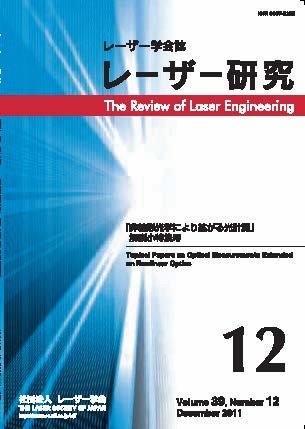All issues

Volume 49, Issue 2
Special Issue on Forefront of Ultrahigh Intensity Laser Development Using Nonlinear Optical Crystals
Displaying 1-7 of 7 articles from this issue
- |<
- <
- 1
- >
- >|
Special Issue on Forefront of Ultrahigh Intensity Laser Development Using Nonlinear Optical Crystals
Special Issue
Laser Review
-
Yoshiaki KATO2021Volume 49Issue 2 Pages 86-
Published: 2021
Released on J-STAGE: April 11, 2024
JOURNAL FREE ACCESSIn this special issue, present status and future prospects of Optical Parametric Chirped Pulse Amplification (OPCPA) are reviewed by the leading laboratories in China, UK, Czech and Japan. This Preface briefly reviews several approaches toward realizing 10 PW ~ 100 PW power, including Ti:sapphire laser, OPCPA, and other approaches such as coherent beam combining (CBC) and Compression after Compressor Approach (CafCA).View full abstractDownload PDF (261K) -
Masaki KANDO, Hiromitsu KIRIYAMA2021Volume 49Issue 2 Pages 88-
Published: 2021
Released on J-STAGE: April 11, 2024
JOURNAL FREE ACCESSWe review some physics phenomena that can be explored with high electromagnetic fields. Such high fields are accessible using modern high-power laser facilities with a peak power higher than petawatt. High fields can modify the vacuum so that the birefringence or a change of refractive index can come into play as it behaves as matter under high laser fields. Moreover, if the field is high enough the field can break the vacuum – an electron-positron pair is generated. Such a field not only allows searches for the nature of vacuum or quantum electrodynamical effects but we even can explore new physics or new particles that are yet to be discovered.View full abstractDownload PDF (822K) -
Yujie PENG, Yi XU,, Lianghong YU, Xinliang WANG, Yanyan LI, Xiaoming L ...2021Volume 49Issue 2 Pages 93-
Published: 2021
Released on J-STAGE: April 11, 2024
JOURNAL FREE ACCESSDevelopment of ultra-intense and ultrafast lasers have promised scientists with unprecedented extreme physical conditions and new experimental techniques. In 2017, the Station of Extreme Light (SEL) project was approved and is under construction at Shanghai now. In this project, a 100 PW laser facility based on all optical parametric chirped pulse amplification (OPCPA) will be developed, which can provide the focused intensity of more than 10 23 W/cm 2. In this letter, the conceptual design of the SEL laser facility is presented. And the latest progress and the status of the frontend R&D, which can be regarded as a small prototype of the SEL facility, is reported. In the future, the SEL-100 PW laser would pave the way for exploring the next frontier of high field physics.View full abstractDownload PDF (2072K) -
Kainan ZHOU, Xiaoming ZENG, Xiaojun HUANG, Xiaodong WANG, Na XIE, Yanl ...2021Volume 49Issue 2 Pages 97-
Published: 2021
Released on J-STAGE: April 11, 2024
JOURNAL FREE ACCESSWe report on a comprehensive high-intensity laser platform which includes two laser facilities for strongfield physics research. One laser facility named the Xingguang-III laser generates femtosecond, picosecond and nanosecond beams with three wavelengths, i.e. 800 nm, 1053 nm, and 527 nm, respectively. The other one named the SILEX-II laser is an all-OPCPA laser with three-stage optical parametric amplifiers and the maximum peak power of 4.9 PW has been achieved. The design and main performance of two laser facilities are described in the paper.View full abstractDownload PDF (1165K) -
Zhaoyang LI, Junji KAWANAKA2021Volume 49Issue 2 Pages 101-
Published: 2021
Released on J-STAGE: April 11, 2024
JOURNAL FREE ACCESSThe famous chirped pulse amplification technology opens the way to the petawatt laser with the peak-power up to 10 15 Watt. In the past decades, especially in recent several years, due to significant engineering improvement, tens of 1 ~ 2-petawatt lasers and two 10-Petawatt lasers have been successfully demonstrated, however, the rapid development seems to have encountered a bottleneck recently. To break through the development bottleneck and further increase the peak-power, technique improvements become indispensable in the near future. In this paper, by analyzing the development trend, recent technological improvements in Japan are introduced. Based on considerations of both peak-power scaling and economic- cost containment, methods are proposed to reduce pulse duration instead of only to increase pulse energy, providing a possible chance to further development of the ultra-intense laser.View full abstractDownload PDF (715K) -
Jonathan T. GREEN, Roman ANTIPENKOV, Pavel BAKULE, Jan BARTONÍČEK, Jan ...2021Volume 49Issue 2 Pages 106-
Published: 2021
Released on J-STAGE: April 11, 2024
JOURNAL FREE ACCESSWe discuss the current development of the L2-DUHA laser system at ELI-Beamlines. L2-DUHA is intended to be a high repetition rate, 100 TW-class laser system whose primary purpose is to serve as a driver for a laser-driven X-ray free electron laser. Optical parametric chirped pulse amplification (OPCPA) pumped by diode-pumped solid state lasers (DPSSL) was chosen as the method of broadband amplification for the laser. We discuss the key considerations in the design of the laser and focus primarily on the broadband front end, the high energy pump laser, and high energy OPCPA stages.View full abstractDownload PDF (1017K) -
Ian MUSGRAVE, Marco GALIMBERTI, Mario GALLETI, Pedro OLIVIERA, Gie ...2021Volume 49Issue 2 Pages 110-
Published: 2021
Released on J-STAGE: April 11, 2024
JOURNAL FREE ACCESSThe Vulcan OPPEL beamline will be a new petawatt level OPCPA based beam operated in conjunction with the existing beams in the Vulcan Petawatt facility and will enable unique pump probe experiments. The specifications for this new beamline are that it will deliver 30 J in 30 fs. This paper presents our latest designs for the beamline and how it will be integrated into the existing facility.View full abstractDownload PDF (2192K)
- |<
- <
- 1
- >
- >|